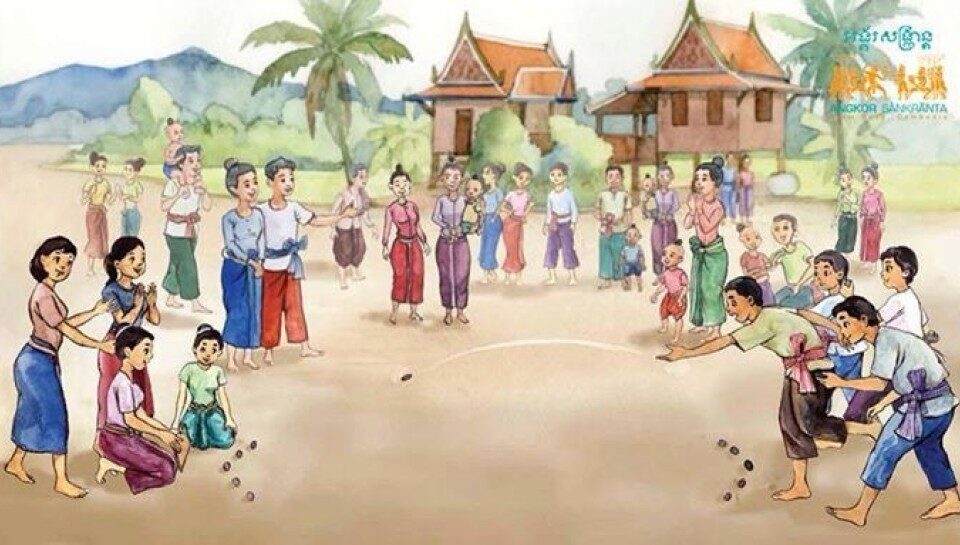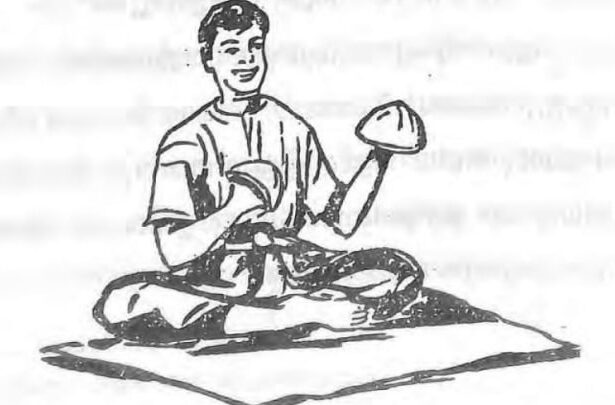Bos Angkunh Game “ល្បែងបោះអង្គញ់” is a popular Khmer folk game played especially during Khmer New Year at villages, or schools, especially at the pagodas. Angkunh is called after one kind of dried fruit from a climbing plant in Cambodia. Normally, this game could help maintain people’s mental and physical dexterity. This game is entertainment, which assists people in coordinating their hands and eyes, and it also enhances the concentration of people.

Angkunh is one of the plant species cultivated in Cambodia, mostly in the provinces of Stung Treng and Kratié. It has long huge branches and large fruits. Each fruit contains many flat and round seeds about 2 to 3 inches in dimension. The seed hardens and smoothes when the fruit ripens, turning dark brown. This seed is made to play the Khmer game “Angkunh,” known as “Bos Angkunh,” which means “Throw the Angkunh.”
How To Play Bos Angkunh As A Khmer New Year Game?
All men and women of all ages can participate in “Bos Angkunh .”Mostly, people play it during the Khmer New Year fun game. The number of participants ranges from 2 to 10, divided into two teams. Men and women can be mixed on both sides.
To start the game, the participants placed 3 or 5 Angkunh in a pyramid configuration facing each other at around eight meters.
Each group is allowed to toss the Angkunh. Although the game’s rules can be differentiated based on different local rituals, the common game rule is that the throwing group should toss the “Kaoy Bos” to shatter the “Kaoy Dam” of the other group, leaving the center seed as the last to be hit.
When the throwing team completely bumps all of the “Kaoy Dam,” and the opposing team cannot bash back, the victors will “Chous” the losers. Nevertheless, if the throwing team destroys the middle seed first, they will lose the other way round.
The “Chous” simply means knock. It is performed by placing one seed against a joint, especially the knee. The shoulder or elbow can also be used alternatively. If the winning group, on the other hand, knocks without making a clicking sound, the loser group gets to knockback.
Arbitrations Before The Game Begins
If you violate any of the rules in this game, you will be penalized instantly. As a result, before starting the game, both parties need to discuss the number of points required to win the game and the penalty conditions for the losing team.
The game begins when the first participant on the beginning team throws an Angkunh at the other team. There is one point awarded for each Angkunh struck, and the player retains his Angkunh for the following throw when it is his time again.
Each player has one throw until one of the team’s players fails to strike the Angkunh. The round is then switched to the opposite team.
The game will keep going until the agreed-upon amount of points is attained, and a winner is decided. The winning team has the right to “gently or roughly” strike the loser’s joint knee with the two flat surfaces of the Angkunh.
The clicking loudness from “Chous Angkunh” makes the players very happy. However, the losers can get their revenge back if the winners cannot knock the losing team’s knees with the expected sound.
Here Are The Game’s Two Main Stages
1. Setup Stage
The players are usually separated into two teams, one for men and one for women. Each squad normally has the same number of members, ranging from 2 to 10.
When each team is ready to begin, they line up along two borderlines approximately 10 to 15 feet apart. Before that, the teams must select which team would throw first and how many “Kauy” will be used.
The game begins with “Kaoy Bos,” meaning throwing seed, and “Kaoy Dam,” meaning planting seed.
“Kaoy Dam” is placed on the field with a series of stems from a central “Kaoy” called “Me Klong or Konlong” 1 or 2 on the right, 1 or 2 on the left, formed like a flock of cormorants, with a leader clearing the way and the groups following obliquely behind.
“Kaoy Dam” sits about 3 or 4 meters in front of the factory, allegedly dubbed “Ti,” a site to toss “Angkunh” to Koy Dam.
The Angkunhs that players used for throwing are called “Kauy Bos”; meanwhile, the Angkunhs determined as goals are called “Kaoy Dam.” The squad can choose between 3 and 5 “Kaoy” options.
Participants tend to play with the “3 Kaoy” game rule with fewer people. Depending on the number chosen, each member on the beginning team will receive 3 or 5 Angkunhs accordingly.
Furthermore, each team will bring one additional set of Angkunh for the “Kaoy Dam”. They dig a slight hole in the ground of the frontier line to position the Angkunhs to take a stand with their flat side fronting the other team.
2. Penalized Stage
The winning team gets to penalize or “Chous” the losing team at the end of each round. Every winning team member will use Angkunh to knock the losers’ knees in this game. The losing team will lean their knees forward as they assemble at the edge of the game field.
“Chous” comes in two forms: “Bay Trorjeak,” meaning cold rice, and “Bay Kdao,” meaning hot rice. This is the agreement that needs to be settled upon prior to starting the game.
In the case of Bay Trorjeak, the winners lay one Angkunh on the loser’s knee flat on its side and tap on top of it with another Angkunh. A little touch is all that is required. Therefore, you should hear a gentle popping from both Angkunh collide when you tap.
There is an unkinder knock for Bay Kdao; players hold two Angkunhs in one hand. They place the first Angkunh in the palm and then wrap the little pinky and ring finger around the round edge.
After that, players use the thumb and index finger to hold the second Angkunh upright, allowing its round edge to almost touching the first Angkunh’s flat base. Spare a quarter-inch to a half-inch spacing between the plates. When the first and the second Angkunh strike, you will hear an amusing clacking sound.
The other person can reverse the hitter if the clicking sound is not heard. This cycle will be repeated until any member can create the clicking sound.
Long story short, the Bos Angkunh game can be played in two ways: simple and extended. No matter how, both forms end with a punishment known as “Chous”, which the victorious team members must execute on the loser team members.
The simple approach involves just throwing the Angkunhs to strike the target Angkunhs. In addition to the throwing step, the extended style includes more stages, including “Si Koul,” “Siparet,” “Trakang,” “Chak Ktek,” and “Bos Chous.”











